Dan Coxon's Blog, page 8
May 17, 2012
A Brief History of Bookmarks
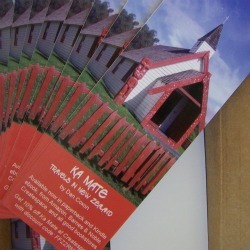 Next time you slide a slip of paper between the pages of your book, spare a thought for the humble bookmark.
Next time you slide a slip of paper between the pages of your book, spare a thought for the humble bookmark.Bookmarks have been around since the 13th century, when they were used to mark points in the long medieval scrolls of the period. Most were of the clip-on variety that seems to have come back into fashion recently (isn't it funny how these things come around?), and several examples have survived to the present day.
By the 18th century books (mainly Bibles and prayer books) were starting to appear with fabric strips sown into the spine, as a way of saving the page without damaging the fragile paper. You still get these in some 'classic' editions - although you probably didn't realize that they're a throwback to the 1700s.
It was in the 1850s that the modern bookmark truly came into existence, however, with the increased production of modern-style books. These detachable bookmarks were similar to the modern concept - a slip of paper or other material that you could slide between the pages to save your place. They also came decorated as they do today, with everything from sponsored advertisements to embroidered works of art. Many had tapered edges, so they could also be used to slit the pages of the books, which still arrived unseparated from the printers - a publishing necessity that led to the current trend for 'deckle edge' literary hardbacks.
Then, finally, in 2012 the Ka Mate: Travels in New Zealand bookmark was released, complete with a discount code for 10% off the book from the Createspace website. Which (as you may have guessed) was the point of this entire piece. I now have a stack of these bookmarks (pictured) on my desk, and I'm excited to set about handing them out. Who knows what pages they may end up between.
Of course, then the ebook arrived, and for some readers the bookmark became as obsolete as those medieval scrolls. But that's where a whole new story begins...
Published on May 17, 2012 08:30
April 30, 2012
The Jumblies (Like The Avengers, But in a Sieve)
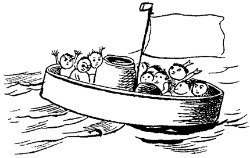 Those of you who know me away from the blogosphere will realise that I've been quiet lately for a very good reason. On February 15th my son Jacob was born, and since then I've been on the helter-skelter newborn ride that some of you will know only too well. Some days I've barely found the time to drink a cup of tea, never mind write a blog post.
Those of you who know me away from the blogosphere will realise that I've been quiet lately for a very good reason. On February 15th my son Jacob was born, and since then I've been on the helter-skelter newborn ride that some of you will know only too well. Some days I've barely found the time to drink a cup of tea, never mind write a blog post.As things slowly return to something that might almost resemble normality, so I've started to have more time at the keyboard. And that means more writing, and more posts on here. First up is my latest essay for The Nervous Breakdown - and, you guessed it, there's a baby theme. A couple of weeks ago I read Edward Lear's nonsense poem 'The Jumblies' to Jacob, and it brought with it a flood of memories, as well as a few revelations. The narrative poem about a tribe of green-headed, blue-handed travelers who set out to sea in a sieve may sound like gibberish, but there are some surprising life lessons in there. And a pig.
If you want to find out more (and even if you don't) then check out my essay Life Among the Jumblies on the TNB site. For those of you who have already gone to sea in a sieve, it might come as a welcome reassurance that you're not alone in your exploration of the Chankly Bore.
As for more writing, stay tuned... Jacob permitting, of course.
Published on April 30, 2012 08:34
March 16, 2012
Every End Has a Start...
 Once upon a time there was a writer. He wasn't a best selling writer, or a famous writer, or even a hugely talented but vastly underrated writer.
Once upon a time there was a writer. He wasn't a best selling writer, or a famous writer, or even a hugely talented but vastly underrated writer.But he did know a few things about structuring a story, and one day the very nice reviewer at Komz Reviews - otherwise known as The Review Girl - asked him to write a guest blog for her website. The result? A blog post about how to begin and end a story, appropriately called 'How to Write Gripping Openings and Endings'. It's quite a gripping read itself, if you like writing. And reading. And discussing story mechanics with examples from classic literature. You can read it by clicking the link above.
And this writer then lived happily ever after. With an endless supply of beer. And an Xbox. The end.
Published on March 16, 2012 09:32
March 14, 2012
I'm A Loser, Baby
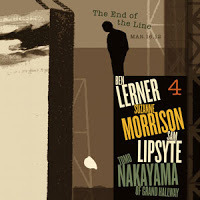 Sometimes winning seems like the only goal worth pursuing. Everyone has their own definition of the big win - getting a new contract, receiving an award, winning the lottery - but we're all heading for the same finish line. We're all in it for the win.
Sometimes winning seems like the only goal worth pursuing. Everyone has their own definition of the big win - getting a new contract, receiving an award, winning the lottery - but we're all heading for the same finish line. We're all in it for the win.I therefore take perverse pleasure in announcing my failure to win the New Works Competition at Seattle's Richard Hugo House. Okay, so I'd have preferred to be a winner (wouldn't we all?), but there's some consolation in knowing that you did a good job despite your loser status. My short story 'Bud' made it to the final four of the contest this year, and of that I am unduly proud. I like to think that if the judges had drunk just a few more mojitos before reading it then I might have come out on top.
Which also leads me neatly on to the winner, Jeff Bender's 'The Guard'. Jeff gave a fantastic class on story structure at Write-O-Rama last year, so I've no doubt that the story is a winner in every respect. The guy knows how to write. As for the story, you'll have to go along to the final event in the 2011-2012 Hugo Literary Series to hear it, where Jeff will debut the story alongside readings from Suzanne Morrison, Sam Lipsyte and Ben Lerner, as well as music by Tomo Nakayama of Grand Hallway. Tickets are still available online here, or by calling (206) 322-7030.
As for the fact that it might have been me standing up on that podium, I'll get over it after a beer or two. Maybe being a winner isn't everything after all.
(Note to editors: 'Bud' is still up for grabs, for the right literary journal. Just sayin'...)
Published on March 14, 2012 08:37
March 11, 2012
Affection for Line Zero
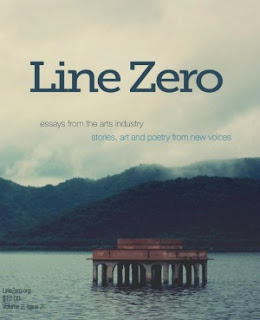 At the start of January, as we all sat under an icy winter blanket, Seattle-based literary/arts journal Line Zero ran a Flash Fiction contest. The prompt was 'Affection', and writers were given 24 hours to come up with a story that clocked in at under 300 words. Always one to rise to a challenge I sharpened my pencils, started some coffee on the stove, and set about cranking up the creative engine.
At the start of January, as we all sat under an icy winter blanket, Seattle-based literary/arts journal Line Zero ran a Flash Fiction contest. The prompt was 'Affection', and writers were given 24 hours to come up with a story that clocked in at under 300 words. Always one to rise to a challenge I sharpened my pencils, started some coffee on the stove, and set about cranking up the creative engine.If you're not familiar with Flash Fiction as a format, then don't be put off by the title - it doesn't involve a soundtrack by Queen, or wearing Spandex pants. The idea is simply to tell your story as concisely as possible, distilling the short story down to a few hundred words. Think of it as an extra-long haiku. If you want to check out a master of the form at work, then get your hands on a copy of Dan Rhodes' Anthropology , 101 stories each told in 101 words (for the UK edition, click here).
I'm pleased to announce that my short short short story 'DSA: Desperately Seeking Affection' was chosen as one of four winners of the Line Zero Winter Flash Fiction Contest, and will appear in the new issue of the journal due March 16th. To order a copy visit the Line Zero website.
As an added incentive, if you order before the close of March 16th you can use the following code to get 15% off - Win2012LineZero. The code works for your entire order from Pink Fish Press, so feel free to go crazy. I know they need your support (and your cold, hard, Paypal cash).
In the meantime, I'll be heading back to the writing board to start something new - just as soon as baby Jacob gives me an hour or two to spare...
Published on March 11, 2012 09:42
February 27, 2012
KA MATE: the Baby Sale!
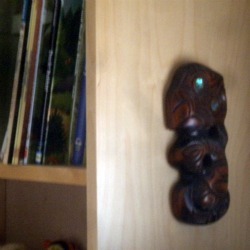 My son, Jacob Coxon, is currently 10 days old. He already has a room full of toys, memorabilia, and more gadgets than 007: a jungle bouncer, a lavender scented hippo, a miniature sock monkey, teething rings, books, cloth books, Pooh, Eeyore, a sheep that makes womb noises... and a tiki.
My son, Jacob Coxon, is currently 10 days old. He already has a room full of toys, memorabilia, and more gadgets than 007: a jungle bouncer, a lavender scented hippo, a miniature sock monkey, teething rings, books, cloth books, Pooh, Eeyore, a sheep that makes womb noises... and a tiki.This particular tiki traveled with us all the way from New Zealand. It was born in Rotorua, to be exact, and was carved at the traditional Maori carving school there. It now hangs on the side of Jacob's bookcase, a reminder of our travels, and the place of our own little man in the bigger scheme of things. When he screams the resemblance is uncanny.
All this preamble is bringing me slowly to my point. From now until March 4th we're running a number of discounts and promotions on my book Ka Mate: Travels in New Zealand , to celebrate Jacob's arrival in the world. Think of it as a baby sale. If you haven't already read the book, it follows my adventures across New Zealand's North and South islands, descending into caves, jumping off mountains, meeting the native Maori people - and, of course, visiting the carving school at Rotorua.
Promotions are running on both the paperback edition and the Kindle ebooks, click the links below to check them out:
Kindle ebook (US edition): $2.99 until March 4th, buy at Amazon.com.
Kindle ebook (UK edition): GBP 1.56 until March 4th, buy at Amazon.co.uk.
Paperback edition: $5 off retail price (new price $9.99). Use discount code HELBUYX5 at Createspace.com.
Published on February 27, 2012 09:03
February 6, 2012
Celebrate Waitangi Day with KA MATE!
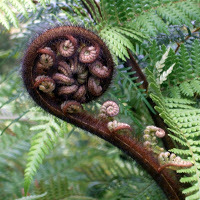 If you're not in New Zealand right now, you'd be forgiven for letting Waitangi Day pass you by. It's not a fixture on the international calendar, and even some Kiwis allow it to slip past unnoticed.
If you're not in New Zealand right now, you'd be forgiven for letting Waitangi Day pass you by. It's not a fixture on the international calendar, and even some Kiwis allow it to slip past unnoticed.If you're into historic celebrations, however, then Waitangi Day is one to pay attention to - the Kiwi version of Independence Day. The Treaty of Waitangi was signed on February 6th in 1840, at James Busby's house in the Bay of Islands, and it marked the founding of New Zealand as a modern nation.
The Treaty is still controversial to this day. If you want to know more about it (and where it was signed) then I suggest you check out my book Ka Mate: Travels in New Zealand .
As a taster, and to celebrate Waitangi Day, here's a short passage from the book on the history of the treaty:
There are many books devoted to the wording of the Treaty and its various points of mistranslation or open interpretation, so I will keep this summary brief. Essentially the first article ceded the rights and powers of sovereignty to the British monarch. The second article, probably the most contentious of the three, guaranteed the Maori chiefs exclusive possession of their land as long as they wanted it, but gave the Crown an exclusive right to purchase these lands should they wish to sell. The third and final article extended to the Maori all the rights and privileges of British subjects, and this article is generally considered to have been fairly well translated – Williams was obviously getting into his stride by that point. The first two articles were poorly translated in areas, however, and thanks to the substandard translation efforts of a British missionary, and the hurrying effect of the French interest, a document was produced that is still argued over to this day. Add to this the fact that many prominent Maori chiefs did not sign the Treaty at all, and that others weren’t even shown it, and you can see why it has remained so contentious.
The Treaty itself wasn’t signed in the house, this formality having taken place on the lawns between the building and the sea. A marquee was erected there from spare spars and sails that Hobson had brought with him on board the HMS Herald, and as I walked across the close-cropped grass I tried to imagine the makeshift construction that had stood there over a hundred and fifty years ago, billowing in the sea winds. A tall and impressive flagstaff marked the point on the lawn where the historic event took place, but the area was now populated by several clusters of tourists, carefully unpacking sandwiches from their backpacks. In the end the leap proved too much for my imagination, and I had to remain content with the artist’s impression of the signing that hung in the Treaty House. Today’s picnickers were far removed from the gathering of proud Maori chiefs that once occupied these lawns.
Ka Mate: Travels in New Zealand is available now in paperback and as a Kindle ebook from Amazon and many other outlets. Click here for Ka Mate availability.
Published on February 06, 2012 12:36
February 2, 2012
An Inequality of Superheroes
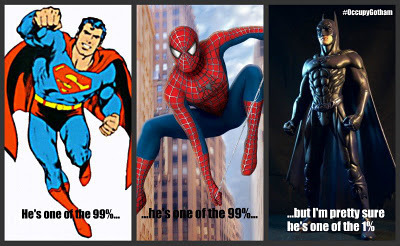
It's been a surprising side effect of the Occupy Movement that everyone has suddenly started paying attention to social equality, or perceived inequalities. If Hoover were still around (and no, Leonardo's make-up artists are fooling no one) he'd have locked us all up for exhibiting Communist tendencies.
It occurred to me a few weeks ago that the 99%-versus-1% argument doesn't work everywhere, however. Specifically, I began to wonder about our superheroes. Batman and Iron Man may be the modern equivalent of the heroes of Greek legend, but they have conspicuously deeper pockets. Bearing in mind that these guys are the biggest box office successes of the past ten years, could it possibly be true that we're still idolizing the rich, even after all the lessons we (should have) learned from Wall Street?
 Well, one thing led to another... and no, I didn't start the Occupy Gotham movement. But I did write a brief memoir of my time spent playing Golden Heroes, a role-playing game that promised to turn us all into Spandex-wearing saviors. It just seemed safer that vigilantism, somehow.
Well, one thing led to another... and no, I didn't start the Occupy Gotham movement. But I did write a brief memoir of my time spent playing Golden Heroes, a role-playing game that promised to turn us all into Spandex-wearing saviors. It just seemed safer that vigilantism, somehow.You can read my essay 'I was a Teenage Superhero' here. Please leave all comments/love/hate mail on the TNB site, I need the visibility folks!
And before you ask, I'm afraid my Spandex-wearing days are over. I do still occasionally wear my underpants over my jeans, though.
Published on February 02, 2012 09:51



